Accepted Scientific Name: Euphorbia degeneri Sherff
Bot. Gaz. 97: 583 (1936)

Chamaesyce degeneri (Euphorbia degeneri) Photo by: Forest Starr & Kim Starr
Habit at Kahuku Pt, Oahu, Hawaii (USA). July 11, 2004.
Origin and Habitat: Euphorbia degeneriSN|28953]]SN|28953]] (syn: Chamaesyce degeneriSN|28954]]SN|28954]]) is endemic to he Main Hawaiian Islands Niʻihau, Kauaʻi, Molokaʻi, Maui, Hawaiʻi except Lana'i & Kahoolawe. On Oʻahu, the only offshore islet it is found on is Kekepa.
Habitat and ecology: Euphorbia degeneriSN|28953]]SN|28953]] is a true coastal plant found in patches in the strand vegetation on arid, isolated rocky coasts, beaches and dunes (about 500 mm year precipitation). It is least disturbed by virtue of the harsh conditions that prevail along the rocky, spray-swept windward shoreline.
Synonyms:
See all synonyms of Euphorbia degeneri
back
Accepted name in llifle Database:Euphorbia degeneri SherffBot. Gaz. 97: 583 (1936)Synonymy: 6
back
Common Names include:
ENGLISH: Beach sandmat, Degener's 'akoko, Beach koko
HAWAIIAN (ʻŌlelo Hawaiʻi): Akoko, Ekoko, Koko, Kokomalei, Kōkōmālei, ʻakoko, ʻEkoko
Description: Euphorbia degeneriSN|28953]]SN|28953]] (syn: Chamaesyce degeneriSN|28954]]SN|28954]]), known in Hawaii as ʻakoko, is a sprawling, prostrate shrub that commonly has a spread of 20-40 cm, but can also have a spread of 60 or more cm in width. This species normally is prostrate, but occasionally (especially in cultivation), it may grow up to a 60 cm tall shrub. The form of the plant is considerably different in cultivation, due to the abundance of rapid growth that it makes. This plant in the summer assumes a purple-red colouring and keeps its leaves in winter. Euphorbia cordataSN|28956]]SN|28956]] is now identified as Euphorbia degeneriSN|28953]]SN|28953]].
Leaves: Small, round to heart shaped, slightly succulent, opposite, distichous (growing in two more or less vertical rows), medium green often with a red tinge in time of drought.
Flower (Cyathia): Not showy, greenish. The flowers of ʻakoko have been described as smelling like bad breath.
Blooming Period: Year Round. Sporadic.
Remarks The name ʻakoko comes from the Hawaiian word koko for blood. They get their name from the red, or blood-colored, seed capsules appearing as drops of blood on the plant.
Notes: The genus Chamaesyce (now lumped in Euphorbia) is represented principally by herbaceous species in continental source areas, but is mostly represented by woody or near woody species in sixteen endemic species of Hawaiian spurge or 'akoko (Chamaesyce spp.) all derived from one or, less likely, two colonizers. The genus Chamaesyce shows the progression from herb to tree with such species as Chamaesyce degeneri (a low herbaceous mat growing in the strand zone), Chamaesyce celastroidesSN|28967]]SN|28905]] and Chamaesyce multiformis that exhibit growth forms ranging from a large but low, quite-tangled, mat of branches; through a somewhat spreading shrub; to a multitrunked small tree to Chamaesyce rockii and Chamaesyce olowaluanaSN|28905]]SN|28967]] that truly qualifies as a tree, growing to 9 m high and occasionally reaching 30 cm in trunk diameter. Also definitely treelike is Chamaesyce herbstii, reaching about 8 m in height. There are at least several reasons for the preponderance of woodiness in the native Hawaiian flora. One of them might be the general tendency of many groups of plants to continue to grow in a climate such as Hawaii islands where there are no winters to bring things to a halt. Another might be, as mentioned above, that whereas "weedy" plants may have been favoured as colonists, there would have been strong tendencies to evolve tree-like species that would be better able to compete for light and space in the forests, particularly the wet forests, of the evolving Hawaiian landscapes. [S. H. Sohmer, R. Gustafson 1987; Alan C. Ziegler 2002]
Bibliography: Major references and further lectures
1) Forest & Kim Starr “Euphorbia degeneri (Akoko)”. Plants of Hawaii. <http://www.starrenvironmental.com>. Web. 27 Sep. 2014.
2) Wikipedia contributors. "Euphorbia degeneri." Wikipedia, The Free Encyclopedia. Wikipedia, The Free Encyclopedia, 14 May. 2014. Web. 27 Sep. 2014.
3) Wagner, W.; D. Herbst; S. Sohmer “Manual of the flowering plants of Hawaii.” Honolulu: University of Hawaii Press 1990
4) Mitchell, Andrew W. “The fragile South Pacific: an ecological odyssey.” Austin, TX: University of Texas Press. 1989
5) Andrew W. Mitchell “The Fragile South Pacific: An Ecological Odyssey” University of Texas Press, 1990
6) Marie C. Neal "In Gardens of Hawaii" June 1, 1965
7) John L. Culliney, Bruce P. Koebele “A Native Hawaiian Garden: How to Grow and Care for Island Plants” University of Hawaii Press, 1999
8) Warren Lambert Wagner, Derral R. Herbst, S. H. Sohmer “Manual of the Flowering Plants of Hawaii” Volume 1 University of Hawaii Press, 1990
9) S. H. Sohmer, R. Gustafson “Plants and Flowers of Hawai_i” University of Hawaii Press, 1987
10) Alan C. Ziegler “Hawaiian Natural History, Ecology, and Evolution” University of Hawaii Press, 2002
11) Brian F. Chabot, Harold A. Mooney “Physiological Ecology of North American Plant” Chapman and Hall, 1985
12) John B. Simmons “Conservation of threatened plants” Published in coordination with NATO Scientific Affairs Division by Plenum Press, 1976
13) St. John, H. 1973. "hist and summary of flowering plants in the Hawaiian Islands. Lawai" Pac. Trop. Bot. Gdn. Mem.
14) Fosberg, F. R. and D. R. Herbst. 1975. "Rare and endangered species of Hawaiian vascular plants." Allertonia 1. 3.
15) Degener, 0. and I. Degener. 1975. "Silverswords and the Blue Data Book." Notes Waimea Arbor. 2(1): 3-6.
16) CROIZAT, L. AN-D 0. DEGEN;ER. 1938. Euphorbiaceae. In: Degener, ed., Flora Hawaiiensis. Privately published.
17) Beatrice Krauss "Plants in Hawaiian Culture" Univ of Hawaii Pr August 4, 2001
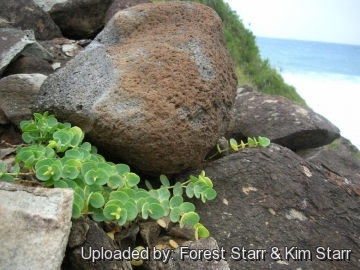 Habit at Punalau, Maui, (USA). March 15, 2005. (Euphorbia degeneri) Photo by: Forest Starr & Kim Starr
Habit at Punalau, Maui, (USA). March 15, 2005. (Euphorbia degeneri) Photo by: Forest Starr & Kim Starr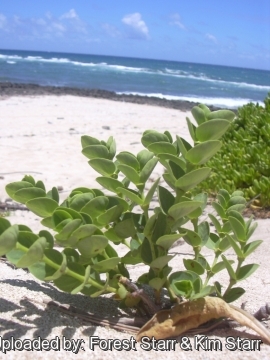 Habit at Kahuku Pt, Oahu, Hawaii (USA). July 11, 2004. (Euphorbia degeneri) Photo by: Forest Starr & Kim Starr
Habit at Kahuku Pt, Oahu, Hawaii (USA). July 11, 2004. (Euphorbia degeneri) Photo by: Forest Starr & Kim Starr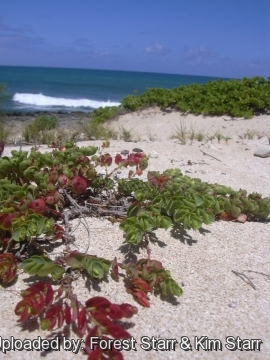 Habit at Kahuku Pt, Oahu, Hawaii (USA). July 11, 2004. (Euphorbia degeneri) Photo by: Forest Starr & Kim Starr
Habit at Kahuku Pt, Oahu, Hawaii (USA). July 11, 2004. (Euphorbia degeneri) Photo by: Forest Starr & Kim Starr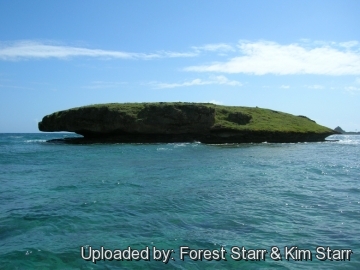 Habitat at Kekepa, Oahu, Hawaii (USA). April 18, 2005. (Euphorbia degeneri) Photo by: Forest Starr & Kim Starr
Habitat at Kekepa, Oahu, Hawaii (USA). April 18, 2005. (Euphorbia degeneri) Photo by: Forest Starr & Kim Starr Flowers at Punalau, Maui, Hawaii (USA). March 15, 2005. (Euphorbia degeneri) Photo by: Forest Starr & Kim Starr
Flowers at Punalau, Maui, Hawaii (USA). March 15, 2005. (Euphorbia degeneri) Photo by: Forest Starr & Kim Starr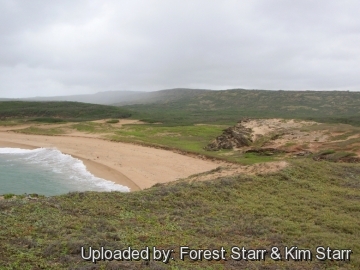 Habitat at Moomomi, Molokai, (USA). May 19, 2005. (Euphorbia degeneri) Photo by: Forest Starr & Kim Starr
Habitat at Moomomi, Molokai, (USA). May 19, 2005. (Euphorbia degeneri) Photo by: Forest Starr & Kim Starr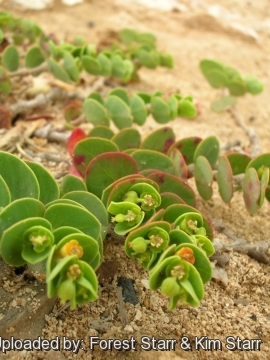 Habit at Moomomi, Molokai, Hawaii (USA). May 19, 2005. (Euphorbia degeneri) Photo by: Forest Starr & Kim Starr
Habit at Moomomi, Molokai, Hawaii (USA). May 19, 2005. (Euphorbia degeneri) Photo by: Forest Starr & Kim Starr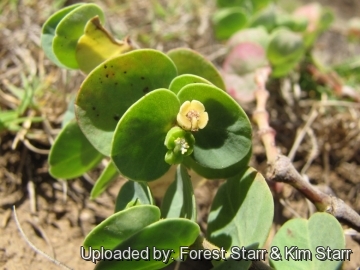 Flowers at Pauwela, Maui, Hawaii (USA). May 17, 2010. (Euphorbia degeneri) Photo by: Forest Starr & Kim Starr
Flowers at Pauwela, Maui, Hawaii (USA). May 17, 2010. (Euphorbia degeneri) Photo by: Forest Starr & Kim StarrCultivation and Propagation: Euphorbia degeneriSN|28953]]SN|28953]] (Chamaesyce degeneriSN|28954]]SN|28954]]) or ʻAkoko is an attractive tropical mat forming species that requires temperatures of 15 °C and full sun to light shade. This plant develops in a fashion similar to a sprawling, groundcover, shrub and is tolerant of heat, wind and drought. Of the several endemic Hawaiian species of Euphorbia which are endangered, this one is perhaps the strangest because of its ease of cultivation. In the wild it lives on extremely poor soil or in pure sand, while seedlings brought into cultivation grow with an ease which is amazing!
Remarks: While there are number very troublesome garden spurges in the same genus Chamaesyce, the Hawaiian ʻakoko does not become such ubiquitous pests in the landscape.
Growth rate: They can spread to half a meter a year and flowering and fruiting in optimal conditions. The form of the plant is considerably different in cultivation, due to the abundance of rapid growth that it makes.
Spacing information: This ʻAkoko should be spaced 30-50 cm apart.
Potting medium: A gritty, very free-draining compost is suitable. As a potted or container plant, use clay, terra cotta or cement pots and incorporate generous amounts of sand, coral rubble, and/or black cinder for good drainage. It has also been suggested to add in a small amount of red clay. Re-pot every 2-3 year.
Fertilization: Akoko respond well to liquid fertilizer (once every one to two months).
Waterings: They like only a short winter's rest and should be kept almost completely dry during the winter months. If the soil is allowed to be dry for too long root loss could follow but equally the same result would occur if the plants are both wet and cold. From March onwards the plant will begin to grow and watering should be increased gradually until late May when the plant should be in full growth. Water regularly during the summer so long as the plant pot is allowed to drain and not sit in a tray of water. During hot weather you may need to water the plants more frequently so long as the plant is actively growing. From late September watering should be reduced to force the plant to go in to a state of semi dormancy, by October you should be back in to the winter watering regime. Outdoor when plant is well established, water once a month or less during dry months. Allow plant to dry between waterings.
Pruning: Generally not necessary to prune plants except to remove dead branches and leaves for a cleaner appearance in the landscape. However this species do tend to get sort of leggy, which is particularly a problem if grown as a potted plant, and pruning is sometime necessary to shape. Repeatedly prunings also help to encourage new growth. A milky, sticky latex naturally oozes from wounds.
Landscape Uses: Accent; Container; Ground Cover. ʻAkoko are great additions to the native garden and fill in those areas in the landscape needing another plant texture.
Hawaiian Uses : The milky sap was one ingredient of the paint used on canoe hulls.
Tolerances: it is tolerant to drought, strong wind, salt sprays and heat. Do not tolerate cold wheather.
Pest and diseases: They are susceptible to fungal diseases. Wet soil quickly causes root and stem rot, especially during winter months. Pests of akoko include whitefly, scale insects, and mealybugs. Often the scale in-sects and mealybugs are brought in and protected by ants. Spider mites can also can damage to leaves.
Propagation: Cuttings root readily and seeds will germinate. . It is best to collect seed just before or just after the capsules split open to be sure to have fresh but mature seeds. Because of the small size of the seedlings, place little or no cover over the seedbed. Take extra care to avoid letting the seedbed dry out. The seeds will begin sprouting in one to two weeks. Let the seedlings grow to about 5 cm in height before separating and transplanting to individual containers. You can also propagate Euphorbia degeneriSN|28953]]SN|28953]] by stem tip cuttings. Take cuttings about 10 cm in length from actively growing tips with mostly green wood. After root growth and new stem growth are obvious, transfer the new plant to a standard potting mix.


















